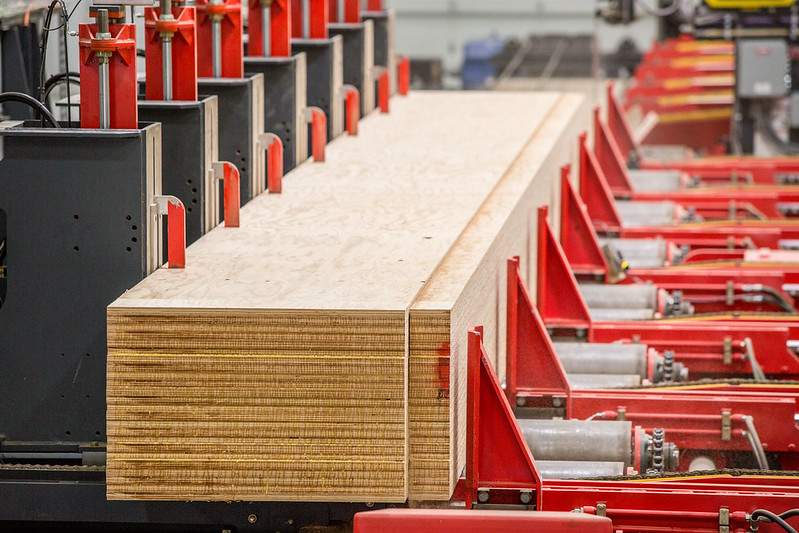Product development projects are ongoing to certify four new laminated veneer lumber (LVL) grades for our Mass Ply Panel (MPP) and Mass Ply Lam (MPL). The intent is to expand our product offering to provide a one-stop shopping opportunity for all the structural material in a building.
The nomenclature for LVL grades includes the Modulus of Elasticity (E) of the material. For example, the 1.6E MPL has a Modulus of Elasticity of 1,600,000 psi. The four grades are:
- 2.1 E or 2.0 E
- 1.8 E or 1.9 E
- Enhanced 1.0 E
- 1.4 E
The 2.1 E and 2.0 E are comparable in performance to LVL products while the 1.8 E and 1.9 E compete with standard Glulam beams. The applications are beams, headers, joists, columns, and MPP lamellas. The enhanced 1.0 E and 1.4 E are for MPP lamella. The F10 MPP is the choice when the design requires strength in two directions. The intent of the enhanced 1.0 E is to improve the performance of the F10 MPP while 1.4 E is for industrial mat grade MPP.

There are several challenges when developing a product certification project. The first is to match the project scope to fully utilize production capabilities and available wood resources. Another important factor is to develop products that are comparable in performance to the competition with product characteristics that are sustainable in quality control and resource availability.
It is difficult to design products that are exact equivalents to designer specified products, so substituting a competitor’s product with ours may require engineering analysis. Deflection limits often control design loads, so it is critical to have a product that meets or exceeds the Modulus of Elasticity of the specified product.
ASTM D5456 Standard Specification for Evaluation of Structural Composite Lumber Products outlines the LVL certification testing requirements. The lion share of the project involves testing under ASTM D5456. ANSI/APA PRG 320-2019: Standard for Performance-Rated Cross-Laminated Timber covers the MPP portion. Both standards require that the APA conduct or witness testing. In addition, the APA audits the process during production of prototype material from the 4’ by 8’ panels at the plywood plant, to scarfing at the MPP plant, and secondary pressing in the Minda Press.

The APA tested the 1.4 E product lay-up during the initial certification testing of MPP and MPL products. The APA may require testing under PRG-320 to meet the requirements for industrial matting.
The current F10 lamella lay-up is the same as the proposed enhanced 1.0 E lay-up. During initial qualification, the lay-up consisted of a1/8” Douglas fir veneer with G-3 Ultrasonic Propagation Time (UPT) grade. The new lay-up has more G-2 veneers. To get the benefit of improved performance with the higher UPT grades, certification testing is necessary. In-house testing of UPT lay-ups targeting the 1.8 through 2.1 grades is complete, and we’re in the process of evaluating the results to determine the next steps in the product development project.
Keep an eye for blogs updating this project’s status. And feel free to reach out to us anytime with questions or comments about new and existing products.
Subscribe
We’ll send you a notification when a new story has been posted. It’s the easiest way to stay in the know.